I’ve returned home from my Montana/Idaho camping trip and overall the trip was spectacular but the good times were tempered by a nasty surprise on my first day there.
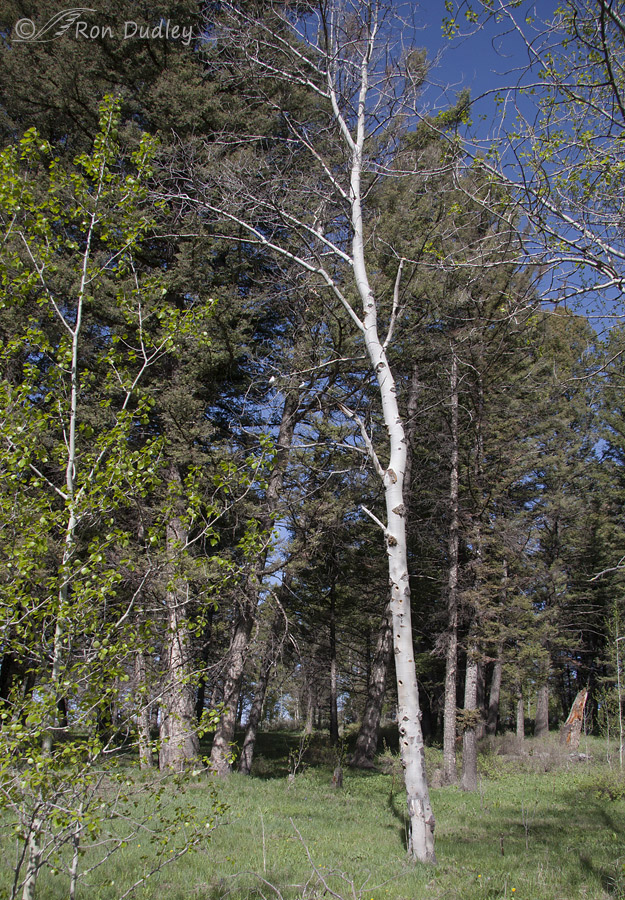
Many readers will likely recall the “Glory Hole Aspen” in Clark County, Idaho because I’ve been photographing birds at this tree since May of 2014 and posting them on my blog. It’s a special tree because it’s loaded with active nesting cavities excavated by, used by or competed for by multiple species, including Williamson’s Sapsuckers, Northern Flickers, Mountain Bluebirds, Red-breasted Nuthatches, House Wrens and Tree Swallows.
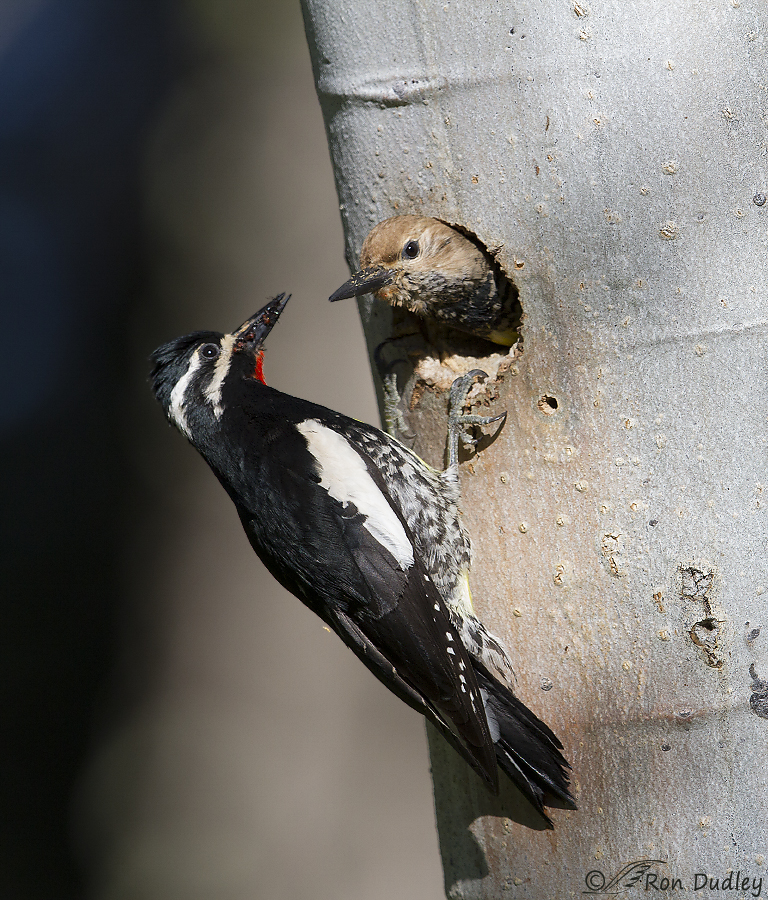
I took this image in June of 2014 as a mated pair of Williamson’s Sapsuckers fed ants to their chicks in one of the many cavities of the aspen. The bill of the male on the left is full of ants and the female has just delivered a load of them so she’s about to leave the cavity.
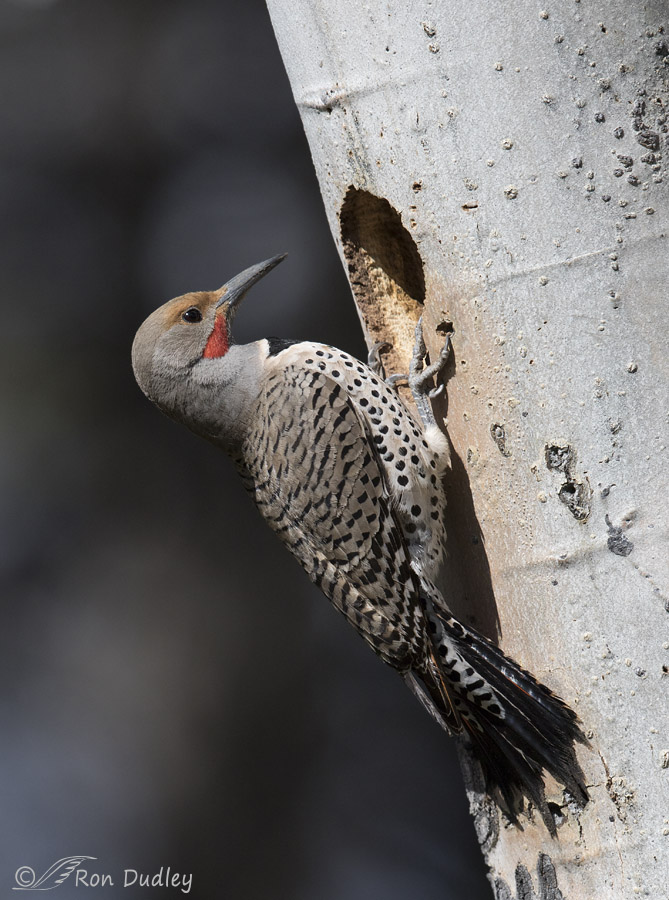
I photographed this Northern Flicker about six weeks ago at the same tree. It was enlarging the same cavity that had been used the previous year by the pair of sapsuckers in the previous photo. This tree has likely been a treasure for birds for umpteen years – literally a nursery for multiple species.
But it no longer exists.
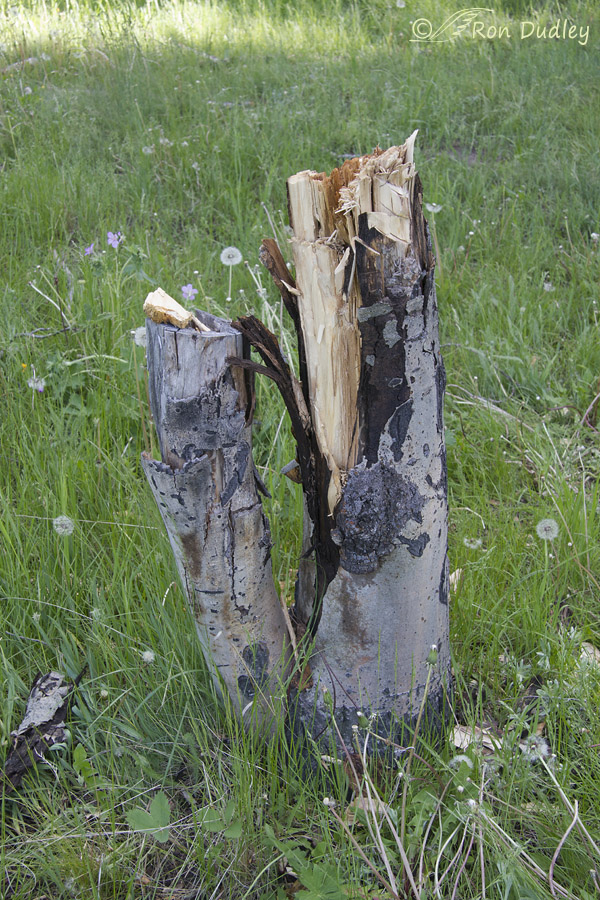
This is what greeted me six days ago when I visited the tree. The aspen had been chopped down – evidence at the scene suggested that an axe had been used initially and then the tree was pulled or pushed over. When it landed the impact broke the brittle fungus-infested wood into sections…
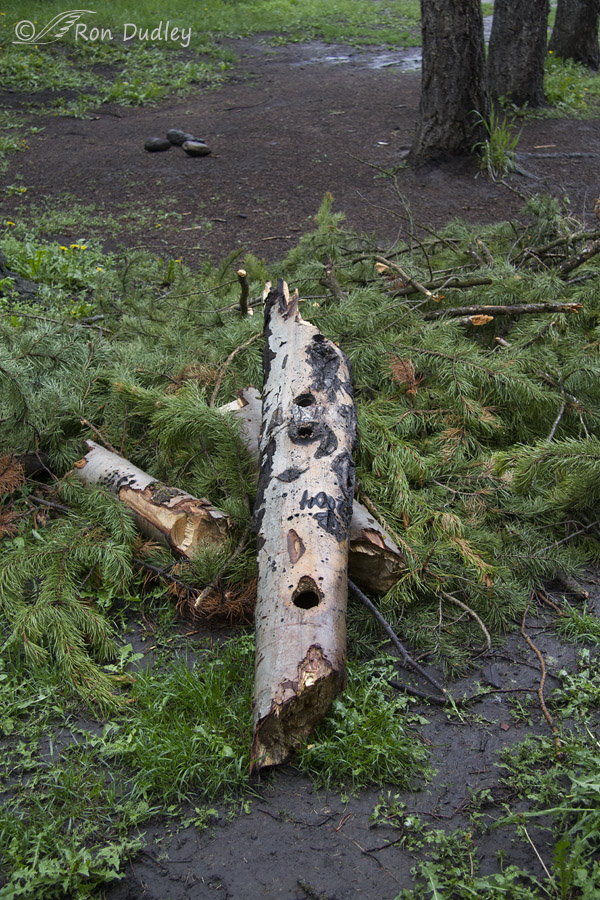
which were then dragged to a nearby camping site, probably for use as firewood (as you can see it had been raining and cold). Here you can see several of the nesting cavities in this section and the upside down “2004” that someone had carved into the bark.
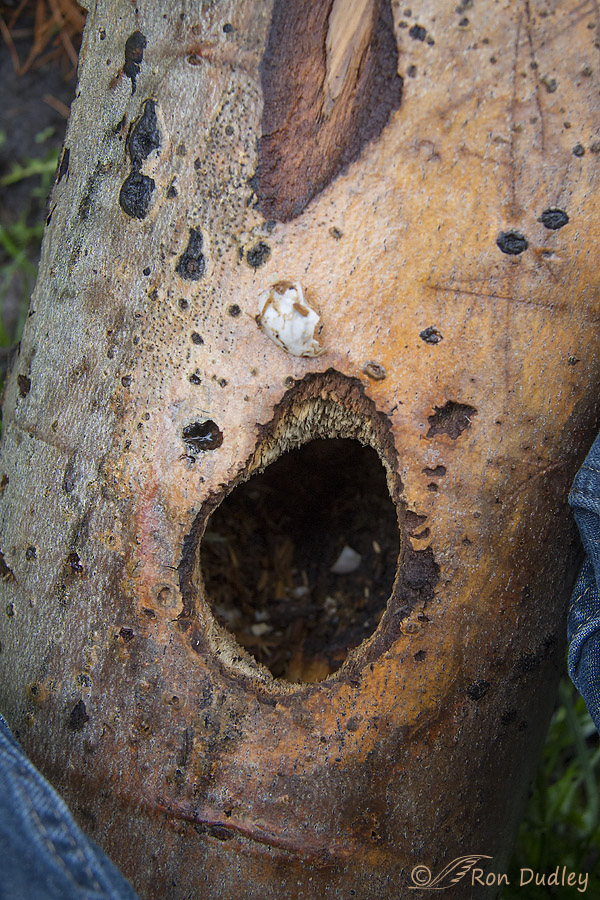
At least one of the cavities contained broken eggs. I reached in and retrieved a piece of debris-covered eggshell and placed it above the hole for this photo (the blue fabric is my blue jeans).
I was devastated by this turn of events – partially for selfish reasons (after all I’m a bird photographer) but mostly for the birds themselves. I was so angry I could’ve spit, or worse. Destroying this tree containing active nests was an illegal and unethical act. Several of the cavities were roughly at eye level while the tree was standing and I’m quite confident that the idiots responsible were well aware of their presence before they cut it down.
But at this point there was nothing constructive to do about it and I was determined not to let the stupidity and callous actions of my own species ruin my entire trip so for the next several days we looked hard for another nesting tree.
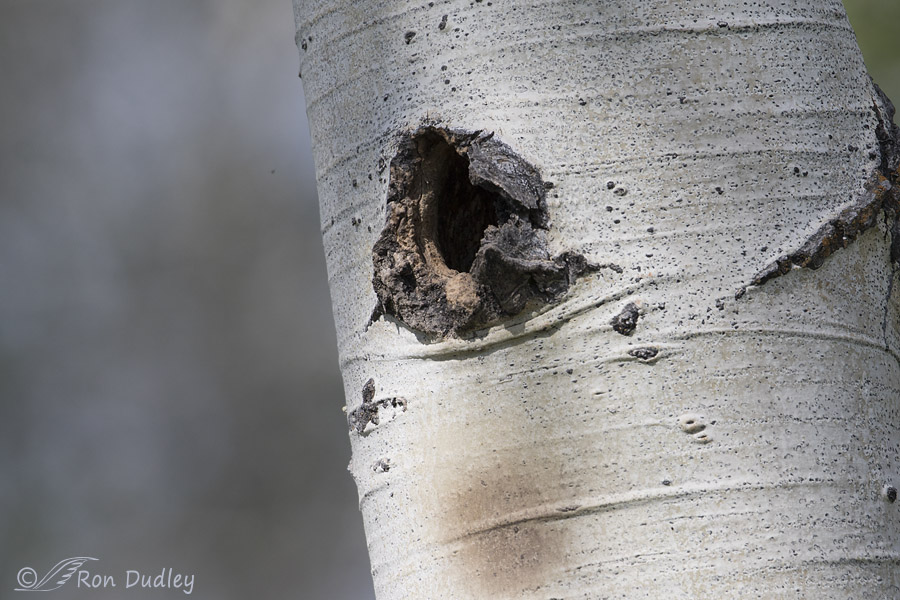
Finding nest cavities in aspens isn’t easy but there are some techniques that increase the chances of success and listening for singing wrens is one of them. Wrens are secondary cavity nesters which means they use cavities excavated by other species. If you find wrens in the spring and early summer you’re likely to find multiple active cavities in the area.
But for me the best visual clue for finding a flicker or sapsucker cavity is looking for the discolored area below any dark spot that may appear to be a hole from a distance. This discolored area is caused by the stiff tail feathers of the woodpecker as it clings to the cavity entrance. When we eventually found this hole we knew that it had been an active nesting cavity at some point but didn’t know if it was active now.
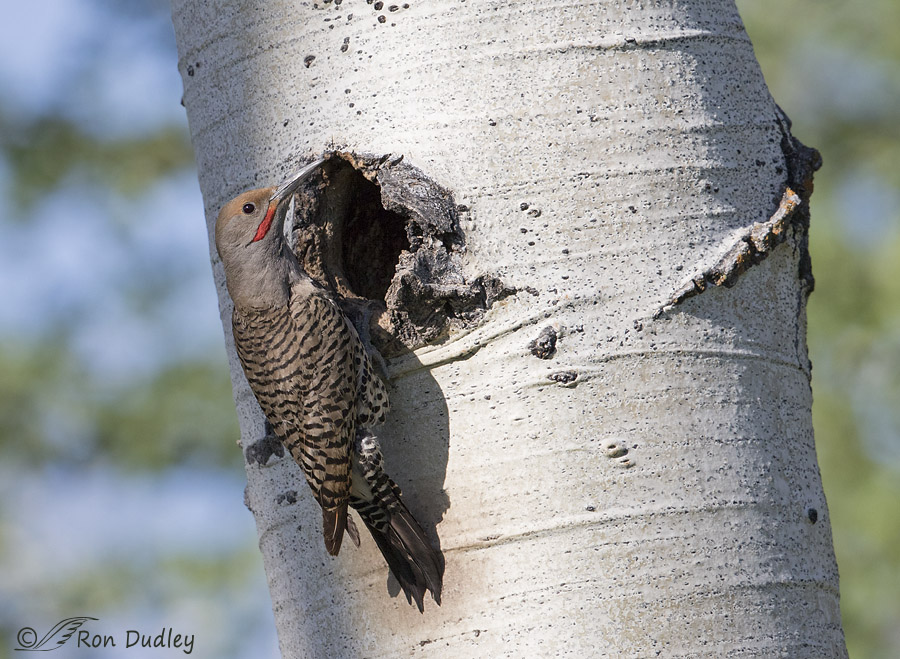
But eventually this male Northern Flicker showed up and removed fecal sacs of its young from within the hole (notice the placement of its tail-tip in the middle of the discolored area).
Because of lighting angles and other issues this cavity and the flickers using it were very difficult to photograph well but I had one chance for an image I’ve been after for a very long time – a flicker in flight showing off its spectacular wing color.
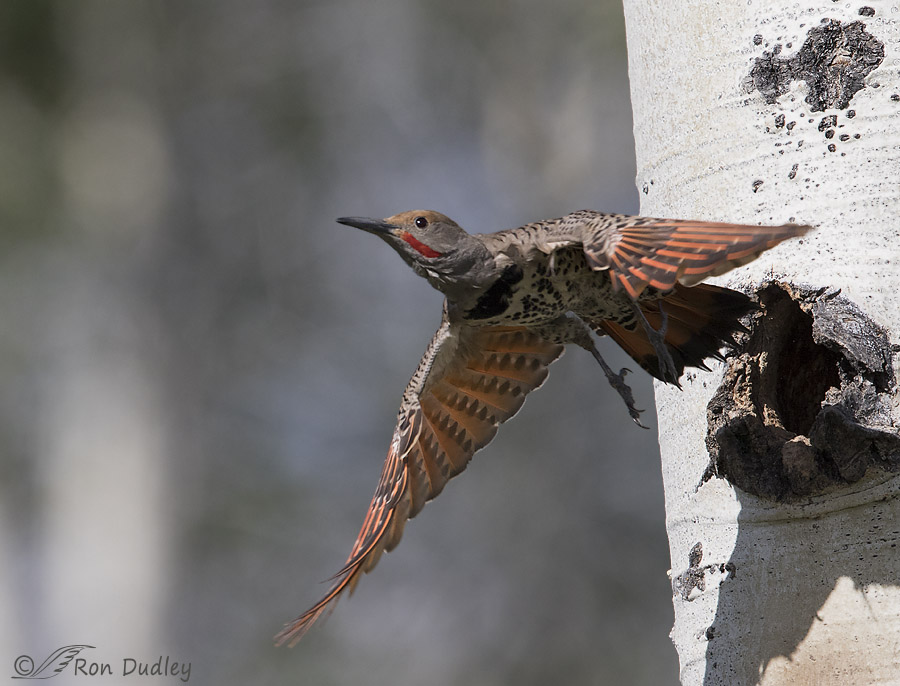
1/2500, f/6.3, ISO 800, Canon 7D Mark II Canon EF500mm f/4L IS II USM, not baited, set up or called in
And I got it in a single shot that I like pretty well (the face could be a little sharper) as the male exited the cavity. I enjoy the color on both wings and the look at the stiff spines at the end of the tail that help to brace the bird against the tree as it clings to the outside of the cavity.
But I’ll tell you what. I’d trade this shot in a heartbeat to have that nesting tree back. For the birds…
Ron
Note: When photographing birds anywhere near nests I’m very careful not to disturb them. I shoot from within my pickup, I use a supertelephoto lens so I don’t have to get close and if I notice any signs of disturbance I immediately leave the area. And I’m nearly always shooting in an area where the birds have been acclimated to the presence of vehicles and human activity.


Humans make my heart hurt. That last image eased that pain but I wish we could all have a little chat with those who chopped that tree down.
Sorry to here of this great tree. I have a spot like that but the birds are in different trees just close together. Great photos as always
Oh this breaks my heart Ron! Stupid idiots abound out there. 🙁
I second what Elephants Child writes… In additon, I hope they love in “interesting times”…
Grief and ballistic rage. And shame for and about our species. I doubt they did notice the nesting holes because it is all about them. About their comfort, their entertainment.
Painful haemorrhoids to the lot of them. And all their ilk. Painful, untreatable haemorrhoids.
YES!!!! HUGE ones!!!
That’s so sad Ron. Three years ago I came across a tree that a Great Horned Owl had been nesting for a few years. My Hubby and I watched her raise her young. Along came tree cutters. Seems they always hire people that do not have a clue on what is going on. The tree with the nest sits back from the road yet they chopped,or should I say butchered, the tree. Nest was destroyed. We never saw the Owls again. Now and then we would see the male Owl resting in a tree not far from the nest. I can understand how you feel.
“I can understand how you feel.”
Based on what you said, Jean, I’ll bet you can.
Many years ago, I had recently flown across country and was bemoaning the fact that the “hand od man” was so evident…crops “quilts”, irrigation circles, a network of roads…etc. “One of these days, the whole country will be covered in blacktop!”, I complained.
” And then, someday, in a tiny crack in the asphalt or cement, a seed will sprout and a flower will grow” , my mother’s friend said, smiling. “And so many will come to see it, someone will eventually decide to charge money just to look…and when that happens, others will break up their own patches of cement or asphalt and plant their own flowers , and soon….!”
I try to think of that when someting like this happens to a tree, a hill side, an in the way of “progress” rock outcropping, etc. because if I don’t, my thoughts turn to homocide….
An interesting perspective, Patty. Thanks for sharing it.
Ohhh… it broke my heart, the minute I saw that stump of the Aspen. We humans are so insensitive to others needs… I am so sad and angry to those people I can’t express… Forgive us little birds…
“it broke my heart, the minute I saw that stump of the Aspen”
That’s what it did to mine, Rima.
Are you kidding? The head could be a little sharper? It’s absolutely the most wonderful Flicker flight shot I’ve ever seen. I am sure that I would have been more than just discouraged by the destruction of the nesting tree, but your perseverance paid off in spades! Congratulations not only on your spectacular shots, but also on your making lemonade !
Charlotte
I’m glad you like the flicker shot, Charlotte – thank you. And making lemonade was the only reasonable choice I had…
Glad you are back.
Not so glad after reading what happened to the “Magic Tree”.
I wish I could be like Jo Ann Donnelly (are the good guys really increasing?) but I feel more like Dick Harlow and you Ron.
And the examples that I see every day (in our schools)gives me less and less hope.
So let’s enjoy Nature while we can.( Beautiful image of the Flicker)
It’s hard to be optimistic about humanity, isn’t it, Jorge?
Hey Jorge & Ron – I totally understand those feelings. Believe me I feel that anger too. However, That’s why we all need to try and get to our young people early to grow the love of nature in them, such as what Susan shared. Again this is where the cams are making it easier. I shared the info with my youngest sister who is a Special Ed teacher & my nephew about the Berry Eagles. They both brought the info to school & in my sister’s & my nephew’s class they shared the cams & the kids brought the info home to their families. Also the AEF offered classroom chats regularly & they have been a big success. I’m sure that Education & exposure to wildlife at a young age can really increase our numbers of the good humuns.
Wow, Ron – I teared up reading about your experience with the Aspen tree being maliciously cut down. but am happy you could find another nesting tree & capture this gorgeous photo of the Flicker departing! I hate what some humans are doing out of either stupidity or purposefully (the 2nd group makes my blood boil)!! However, because of these tragic acts by some we miss the great number of caring people out there who work to care, save & rehabilitate our wildlife. I also have to say for myself that because of Facebook(this is one of the good things about it/won’t go into the downside)I discovered the Bald Eagle nest cam at Berry College. That cam led me t nest cams in SW & NE FL, the Dollywood/AEF nests, African Black Eagles, and many more. This exposure brought me to your site, Ron, as well as the Audubon Society, The Cornell Lab and the Hawkwatch site and many Wildlife Refuge & Rehab centers. This has really opened my eyes & greatly increased my awareness of the wildlife around me. If this has happened to me, it HAS to have impacted many others. Don’t give up on humans because of the bad humans out there – hopefully the numbers of good guys are increasing!!
Jo Ann, One of my favorite organizations similar to some of those you mention is the Cascades Raptor Center in Eugene, Oregon – http://www.eraptors.org/. They do wonderful work and the executive director, Louise Shimmel, is extremely knowledgeable and tireless in her dedication to wildlife, as are the members of her staff.
Don’t worry, I won’t “give up on humans” entirely. Like you I encounter many folks with good hearts and good intentions toward nature. But dammit, the other side seems to be “winning” and it’s very difficult to not be discouraged…
The demise of the nesting tree at the hands of humans makes me sick to my stomach. As one who has always been closely connected to the wild things around me – plants, animals, insects – I cannot fathom people not having that connection, even though I know there are many who don’t. That’s one reason I’m always happy when we can guide school groups out at Hueco Tanks – it helps to teach kids what’s out there and to get them interested. Where the disconnect occurs for me is why someone who clearly has no understanding of, or interest in nature, is out camping…
“Where the disconnect occurs for me is why someone who clearly has no understanding of, or interest in nature, is out camping…”
Boy did that statement ever ring a bell with me, Susan! I see folks doing things while camping that simply make no sense for exactly the reason you mention.
Keep up the good work…what you do is so terribly IMPORTANT! Whatever hope there is , lies in the efforts of people like you!!! Thank you!!!
Thank you, Patty!
WOW! The old name Red-shafted Flicker stands out with your last shot, just beautiful!! Congratulations!
The older I get the more convinced I am of the disconnect more and more humans have with the natural world. We are bombarded by videos of man in the wild or man with animals, then go about our business in our artificial world, town or city. Much of the appreciation for wildlife, their needs, is pushed aside for our comfort and enjoyment. Very sad! I can’t believe there wasn’t other wood available for a fire without destroying a nesting tree! I can understand your anger.
“I can understand your anger.”
Thank you, Dick.
The word “anger” doesn’t come close to describing my emotions over this, especially at the moment of discovery. I looked for a better, more accurate word to use but any that came to mind weren’t appropriate for a family oriented blog…
Rage could work…
Yup, it would, Susan.
Sadly, I echo everything you said, Dick. The disconnect really scares me! How can we expect people who have so little contact with the natural world care about it enough to want to protect it…or even know how….So sad…Amazing image of Flicker, unusual view point, angle…great detail and light. Love the colors.
Thank you, Patty. I guess about all we can do is keep on trying – trying to educate folks and encourage some appreciation for the wonders of nature. And trying to nudge them toward being less self-centered.